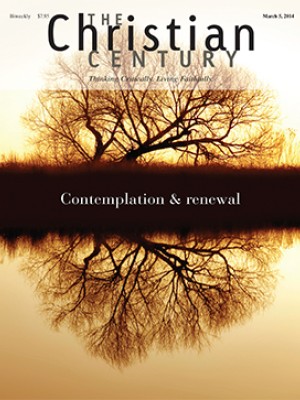Another grief observed
Flannery O’Connor once compared her chronic illness with a visit to a foreign country. It’s like no place you’ve been before, maps don’t help, and postcards can’t do it justice.
The same might be said of grieving. Everything you thought you knew about depression, anger, guilt, and self-deception doesn’t quite fit the category of grief, which in the wisdom of Freud and the shifting conclusions of modern psychiatry hovers perilously between normal and medically deviant, depending on how long it takes you to return to the land of the living.
Contemporary culture’s formulas for recovery—get over it, move on, turn the page—reflect our impatience with the unresolvable or the chronic. We are uncomfortable with anything that must be endured rather than deleted. The word closure, for example, gives to grief a tidiness usually associated with a tweet, a deal, or a game. The real purpose of the formulas, of course, is not to aid the bereaved but to allow the rest of the world to get on with its business. The famous “stages of grief,” made popular by Elisabeth Kübler-Ross’s book On Death and Dying, inadvertently put the dying and their survivors on a schedule. What originated as a schematic description quickly escalated into a prescription for dealing with death.
Read our latest issue or browse back issues.
The Yale bereavement study of 2007 largely validated the stages theory of grief, but with important modifications. It found that the most common and enduring negative reported by the bereaved is not anger or depression but a sustained longing for one who is no longer here. Eight years after her five-year-old died of cancer, his mother reports “this insatiable craving for the unobtainable, and, you know, Michael’s physical presence.”
While it is true that the experience of death and loss does not follow an ordered progression, the complaints of those who grieve are remarkably similar. In Levels of Life, the celebrated British novelist and essayist Julian Barnes offers an anecdotal account of his own grief following the death of his wife of 31 years. If the title hadn’t already been taken, he might have called his essay A Grief Observed. What makes his observations noteworthy is the deep clarity with which Barnes examines the experience of loss and, for Christians, the palpable absence of God from his reflections.
As to the pattern of grief and its complaints, they are roughly the same, whether in Julian Barnes, C. S. Lewis, Joan Didion, or Joyce Carol Oates, each of whom has written a book about grief following the death of a spouse. Each has produced a literary selfie, a snapshot of an experience that by definition is highly personal and self-absorbed. Yet they might be describing the habits of grief in any of us. Lewis and Barnes, believer and unbeliever, long for the lover they cannot have and flail against the attempts of others to comfort them. Lewis refuses to live in the past or to rely on memory or love in the abstract. He will be satisfied by nothing less than “to love the very Her.” Barnes talks to his wife incessantly: “I keep alive our lost private language. I tease her and she teases me back; we know the lines by heart.”
Everything Barnes and Lewis say about grief, including its vegetative aspects, will sound familiar to those who have been there. Barnes devotes himself to hours of meaningless (as opposed to meaningful) football games on TV. Lewis quits shaving and neglects his personal hygiene.
Among their comforters, honest language is the first casualty. Barnes takes note of the usual circumlocutions that hurt more than the truth itself. The word passed instead of died grates on his British ear perhaps more than it would on American sensibilities. Ham-fisted attempts at theodicy are first endured with gritted teeth and finally, toward the end of his essay, accepted as the well-intentioned remarks of those who don’t know what to say. Much worse are the silences. At a dinner party with old friends, Barnes vows to speak of his recently dead wife no matter how socially transgressive the practice. He mentions her three times, and three times “the Silent Ones” miss their cue. “Afraid to touch her name, they denied her thrice, and I thought the worse of them for it.”
The agnostic Barnes’s attempt to console himself with “it’s just the universe doing its stuff” recalls the believer Lewis’s recoil from the “goodness” of God. In fact, the categories good and bad no longer work for him: “The terrible thing is that a perfectly good God,” says Lewis ruefully, “is in this matter hardly less formidable than a Cosmic Sadist.” For atheists and agnostics the main issue boils down to the question, Is there a God? which they treat as the final rather than the first question. Lewis requires more than a yes or no answer. The question that tortures Lewis is not the speculation of the agnostic—Does God exist?—but the agony of the theist: Since there is a God, what kind of God do we have? “Not that I am (I think) in much danger of ceasing to believe in God. The real danger is of coming to believe such dreadful things about Him.”
At first, the believer too may be paralyzed by the agnostic’s question, but he or she then stumbles on to reengage with the One who faded to black when needed most. The Disappearing God has unexpectedly shown up in your life again, like an unreliable friend or a deadbeat dad. How to react? Lewis does not stage a dramatic reunion with God. His grief does not “break” in a revelatory moment, nor does his longing gradually diminish to the point that the idea of God once again makes sense.
Lewis’s turn to God begins with thoughts of God’s “badness,” which he quickly dismisses as anthropomorphism. The point of imagining any sort of God, however, serves the purpose of reintroducing the element of mystery, and mystery leaves the door ajar to hope. He begins to recover not by defiantly staking his case on the Bible or dogma, but by examining his own ignorant and doubting heart.
Both Lewis and Barnes voice the commonplace desire of the bereaved to endure the pain and to die in place of the beloved. “Why couldn’t it be me?” they inquire of no one in particular. The turning point in A Grief Observed occurs in the wake of this ordinary fantasy. Lewis writes, “It was allowed to One, we are told, and I find I can now believe again, that He has done vicariously whatever can be so done. He replies to our babble, ‘You cannot and you dare not. I could and dared.’” Lewis will travel on to praise, joy, Eucharist, and resurrection itself, but the journey begins where it always begins, in an honest assessment of grief.
In Barnes’s agnostic version of A Grief Observed, there is no God to explain death or comfort the bereaved. Unlike the popular atheists whose dogmatism he finds offensive, Barnes takes no satisfaction in the modern demise of God. “When we killed—or exiled—God, we also killed ourselves. Did we notice that sufficiently at the time? No God, no afterlife, no us.” Barnes can be accused of wanting to have it both ways: he insists on the nonexistence of God, but he also gives expression to the wistful regret of modernity, whose God is not really dead dead but only far, far away.
Still, there is much for believers to learn from the unbeliever. Why is it that nonbelievers like Christopher Hitchens or Julian Barnes have the courage to look the beast in the eye in a way that Christian writers seldom do? How is it that they capture the tragic aspect of death better than so many religious “celebrations of life” that only deflect the work of mourning?
On my way out of town, I often pass a huge advertisement for a fitness center. It shows a buff young guy, towel around his ample shoulders, still glistening from the morning’s workout. The caption reads, “The human battery: infinitely rechargeable.” I wonder who will break the news to our clueless invincibles? What politician, prosperity preacher, or pharmaceutical rep will tell us the truth about ourselves? Christians hear it most clearly every Ash Wednesday: “You are dust, and to dust you will return.” Barnes’s eloquent reflections on mourning remind Christians of the very thing we are prone to forget: whenever we minimize or mask the reality of death, we minimize the power of Christ’s victory over it. In the words of John Updike, we make the resurrection “less monstrous.”
Dietrich Bonhoeffer was expressing a similar thought when he described death, loss, or absence as a “gap.” It was Christmas Eve 1943, and he was thinking about the future and feeling the worst kind of loneliness. Writing from his prison cell, he said that most religious people think it is God’s job to fill up the gap with compensations and inspirational thoughts. Not really, he said. God keeps the gap open so that we may continue in communion with the absent one, “even at the cost of pain.”
Like most who grieve, Barnes looks for patterns that will shed light on the death of a loved one and locate it within something larger than itself. These are the everyday repetitions that give meaning to life and whose disappearance adds poignancy and pain to death. Barnes says belief in a pattern is essential, and we cannot survive without it. Christians also seek a pattern, and, as in the case of Barnes, we often fail to see it clearly. When it disappears from view, we rely on others in the community to make the pattern visible again and to perform it on our behalf.
Barnes asks finally, “What is ‘success’ in mourning? Does it lie in remembering or in forgetting?” It is a great question, asked in the spirit of Bonhoeffer. There are places in the Bible in which God promises to forget. “I will forgive their iniquity, and I will remember their sin no more.” In other passages God promises to remember. “Can a mother forget her nursing child?” God asks Israel, “Even these may forget, yet I will not forget you. See, I have engraved you on the palms of my hands.” Forgetting and remembering are both the same to God. In fact, forgetting old grievances is God’s way of remembering Israel with steadfast love. God’s way of remembering is more than recollecting a distant acquaintance. It is an act that re-creates the one who is lost. In rising from the dead, Jesus was performing God’s memory, as if to say, “See, this is how I will remember you.”
Barnes’s essay on grief is best read as the coda to his earlier best seller, Nothing to Be Frightened Of. In it, he subjects himself to the double whammy of reflection on death and the rejection of God. He serves it up with great gallows humor and not a little wisdom. On the human tendency to project one’s personal idea of God onto the heavens, be it a prime mover, clockmaker, old man, wise woman, and so on, he offers Christians yet another helpful reminder: “What counts is what He, She, It or Nothing thinks of you rather than you of them. The notion of redefining the deity into something that works for you is grotesque.”
What is most striking about the earlier work is its witty focus on Barnes himself, his personal reflections on God, and his own anticipated engagement with death. Perhaps it’s easier to retain the ironic mode when contemplating one’s own cosmic fate, for there is a part of your heart that has not yet been touched. In Nothing to Be Frightened Of it does not occur to him that one day he will be writing Levels of Life, in which his subject will not be his own theoretical death but the real death of someone he desperately loved. The movement between the two memoirs is one of tone, not ideas, just as a believer might move, or be wrenched, from the abstractions of dogma to the textures of daily life and grief.
One cannot read Julian Barnes and C. S. Lewis together without recognizing the common features of grief but also searching out the differences. Does the lived experience of grief differ for Christians? How? St. Paul cautions us to “grieve not as those who have no hope.” The hope borne of God’s great memory and Jesus’ resurrection separates the believer’s experience of grief from the unbeliever’s. Ours is a hopeful grief that stops just short of despair. But tears are tears, and Paul also reminds us, “Hope that is seen is not hope.” Despite the best-selling claims of those who have been to heaven and back, hope continues to defy documentation.
C. S. Lewis did not insist on proof of the afterlife; all he wanted was to keep on loving his wife—as he put it, “to love the very Her.” In what sense can any of us love the one who has died, not just a vivid memory or a self-generated presence? This is the secret battle every mourner wages—and mostly loses. Just because it’s a quiet fight, one should not underestimate its fierceness.
Christians come to the battle believing that those who have died in the Lord remain as essential members of the communion of saints. They live. They intercede for us. They meet us at the communion table. Such a conviction does more than assure us of their survival in heaven. I believe it enables us to love them, the “very them,” as friends and companions of another realm. What William Faulkner said about southern history—“The past is never dead. It isn’t even past”—Christians proclaim about the saints. The old boundary between present and past has been breached by God’s amazing memory and Jesus’ more amazing resurrection from the dead. The result, however, is quite ordinary. It is the gift of love, even, as Bonhoeffer said, at the price of pain. We shouldn’t be surprised.







